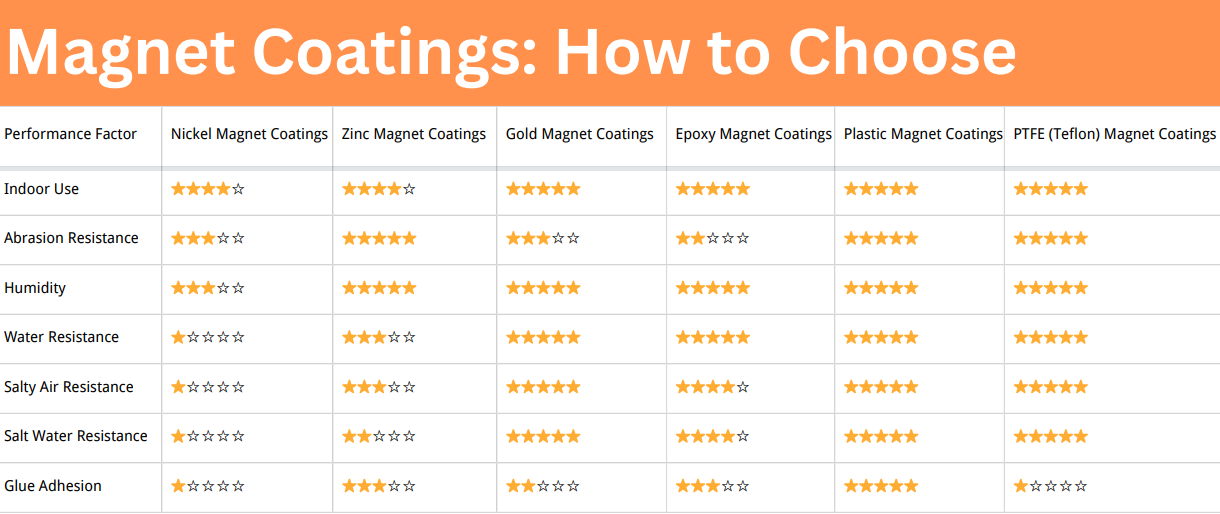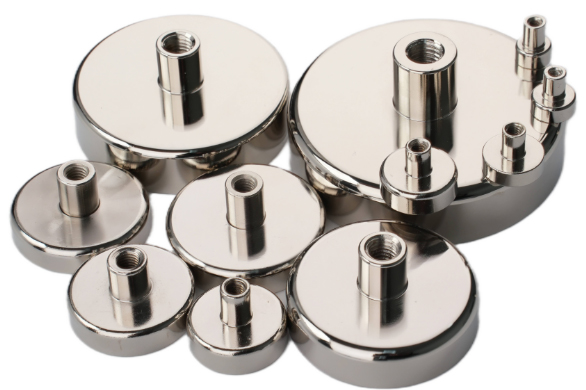Magnet Coatings: How to Choose
Why Magnets Are Coated
Magnet coatings are far more than an aesthetic overlay-they're necessary to preserve the integrity of the magnet and ensure consistent performance for millions of years. In a wet or chemically hostile environment, nearly all permanent magnets-most certainly neodymium magnets-are extremely corrosion-sensitive. If not coated, they will rapidly oxidize, which diminishes magnetic force and degrades structural strength.
Beyond protection against corrosion, coatings offer
- Protection against physical chipping or cracking
- Impart heat or chemical resistance
- Reduce electrical conductivity (in some applications)
- Enhance adhesion to housings or surfaces
- Enhance safety in handling

Common Magnet Coatings
1.Nickel Magnet Coatings
The most usual magnet coating is nickel, typically a triple-layer of nickel-copper-nickel plating. It provides minimal corrosion protection in ambient atmosphere and possesses a bright metallic surface. It is not very resistant to wet or salt environments, however. It gives minimal chipping resistance too. With a mean thickness of 15–25 µm, nickel coatings are cheap and compatible with applications like motors, sensors, and general industrial application. Working maximum temperature is around 200°C.
2. Gold Magnet Coatings
Gold-coated magnets are commonly used in medical implants, especially within the human body. Gold is also biocompatible and FDA-approved for use in internal applications. It's applied on top of a nickel-copper-nickel underlayer and offers very little corrosion protection—salt spray can eventually get through. Gold coatings are extremely thin (0.1–1 µm), extremely decorative, and expensive. With both an application in aesthetic and biomedical purposes, gold has a melting point of approximately 1,000°C, although the working temperature is limited to approximately 200°C.
3. Zinc Magnet Coatings
Zinc plating provides comparatively mild corrosion protection and can be easily bonded with adhesives for magnets. The coating is lighter (7–15 µm), and therefore a narrow air gap between steel and magnet. White-blue or black zinc-coated magnets are appropriate for economy-conscious, low-temperature applications. Their moisture resistance is extremely low.
4. Epoxy Magnet Coatings
Epoxy coatings have excellent resistance to saltwater and high humidity and are a popular choice for marine and automotive uses. Epoxy is very soft and scratchable but strong adhesive and high-thickness protective coating (15–30 µm). Black in color, but can be tinted to match. Medium price with a highest working temperature of 200°C. Ideal for harsh or moisture-stain conditions.
5. Injection-Molded Plastic Magnet Coatings
This involves encapsulating magnets in thermoplastic plastics, offering greater resistance to impact, corrosion, and moisture. Plastic coatings are usually 1–2 mm thick and may be produced in almost any color. Due to mold requirements, they're best suited to medium-to-large magnets and large-volume runs. Plastic coatings are also simple to clean and are best suited to educational and consumer product environments.
6. PTFE (Teflon) Magnet Coatings
PTFE coatings have better chemical and fluid resistance, especially for the medical and food processing sectors. Molded PTFE provides robust cover for the bigger magnets, while sprayed PTFE can be used to coat even small magnets. Both are scratch-resistant to a point but suffer with age. The coatings are typically 1.5-3 mm thick and can be exposed to temperatures up to 250°C. Adhesion is poor, so a mechanical grip is typically needed.
7. Rubber Magnet Coatings
Rubber-coated magnets offer excellent resistance to mechanical stress and corrosion and high metal surface friction. They are widely used in holding and mounting systems, particularly where slippage must be avoided. Rubber coatings are typically thin (about 0.5 mm), black, and mold-requiring. These magnets are better suited to large sizes.
How to Choose the Appropriate Magnet Coating
--Environmental Exposure
If the magnet is to be used in dry indoor applications, decorative nickel, zinc, or other finish coating may suffice. For wet or exterior use, more durable forms such as plastic coatings, epoxy, or PTFE (Teflon) are better. Where chemically aggressive or exposure to saltwater is involved, parylene, PTFE, or an epoxy coat of adequate thickness should be used for greater corrosion resistance.
--Mechanical Stress and Handling
For magnets to experience high friction or shock while in usage, rubber or molded plastic coatings are ideal because they give excellent shock absorption and holding of surfaces. When used in precision parts where minimal air gap is required, thinner coatings such as zinc or nickel are desirable.
--Medical Applications
With respect to the application, the material should be biocompatible
For medical application, especially for implants, coatings such as gold, parylene, or titanium nitride (TiN) would be suitable since they are safe to use internally and biocompatible. For medical devices used externally, coatings such as nickel, black nickel, or epoxy may be employed without any loss in safety.
--Thermal Requirements
If the magnet is to be used in high-temperature environments, select coatings that can endure high temperatures. Titanium nitride is suitable for up to 500°C, PTFE up to 250°C, and nickel coatings up to about 200°C.
--Cost and Quantity
For cost-conscious projects, nickel and zinc give effective protection at a reasonable price. On large-volume production use, molded coatings—even though initial tooling cost—are economical because of lower costs per piece in quantities.
--Adhesion and Assembly
Some coatings, such as zinc and epoxy, have decent adhesion when bound to steel or plastic using magnet-rated epoxies or glues. Some coatings, such as rubber and PTFE, will not adhere and need to be mechanically fastened for proper attachment.
Conclusion
The choice of a suitable magnet coating is a matter of balancing protection, performance, and expense. Careful selection ensures your magnets work well and reliably throughout their lifetime. For more information about magnet coating, please check Stanford Magnets.














